Brief
 }
}
Cloud computing has taken the technology industry by storm. Bain estimates that revenues for public and private cloud hardware, software and services amount to $180 billion, or 16% of the $1.1 trillion enterprise IT industry. From 2012 to 2015, cloud demand accounted for 70% of related IT market growth, and we expect it to represent 60% of growth through 2020 (see Figure 1). Technology providers that fail to compete and win in tomorrow’s cloud computing market risk missing out on this important source of future growth.
In 2011, when we wrote “The Five Faces of the Cloud,” our first Bain Brief on this topic, few would have predicted how quickly this market would evolve. Most cloud demand was from start-ups and small and mid-size businesses. Security was a major concern, inhibiting large enterprises in particular from adopting cloud computing in a meaningful way. Nearly all of the cloud profit pool was earned by technology providers that sell the components to build public and private clouds, rather than by public cloud service providers that sell to end customers.
In 2017, the picture has changed dramatically. Of the Fortune Global 50 companies, 48 have publicly announced cloud adoption plans, many of which use the cloud for a broad swath of their IT environments. Security remains the top concern, but those doubts have moderated, as have concerns over uncertain cost savings and loss of control. New concerns have emerged around compliance, vendor lock-in and data portability (see Figure 2). In spite of these, profits for total cloud computing from both public and private cloud services and components are four times greater than in 2012, and cloud service providers that sell to end customers now command 20% of total profits, whereas profits for these providers were nearly nonexistent in 2012.
Five years ago, it was challenging to discern the economic costs and benefits of cloud solutions, and that uncertainty kept some customers on the sidelines. Now we’re seeing companies like TSO Logic emerge with solutions to help companies analyze a wide range of cloud migration paths in real time and determine what the costs and benefits would be for each workload. The results of this analysis prove that some customers were wise to wait: At a large retail customer, for example, TSO Logic found that for 29% of the company’s instances, a direct-matched solution from Amazon Web Services (AWS) would save more than 25% compared with an on-premise solution; for another 41% of instances, however, AWS would be at least 25% more expensive.
While the growth in cloud computing has defied the expectations of many, there is evidence that the cloud is still in the formative stages. Bain estimates that more than 90% of current customer demand for the cloud comes from replacing or upgrading existing, non-mission critical applications and from the creation of new digital businesses. Most customers are not yet using the cloud to fundamentally change or reimagine how work is done, or to connect business processes to create new value. Many customers still use public or private cloud services for a small percentage of their IT needs.
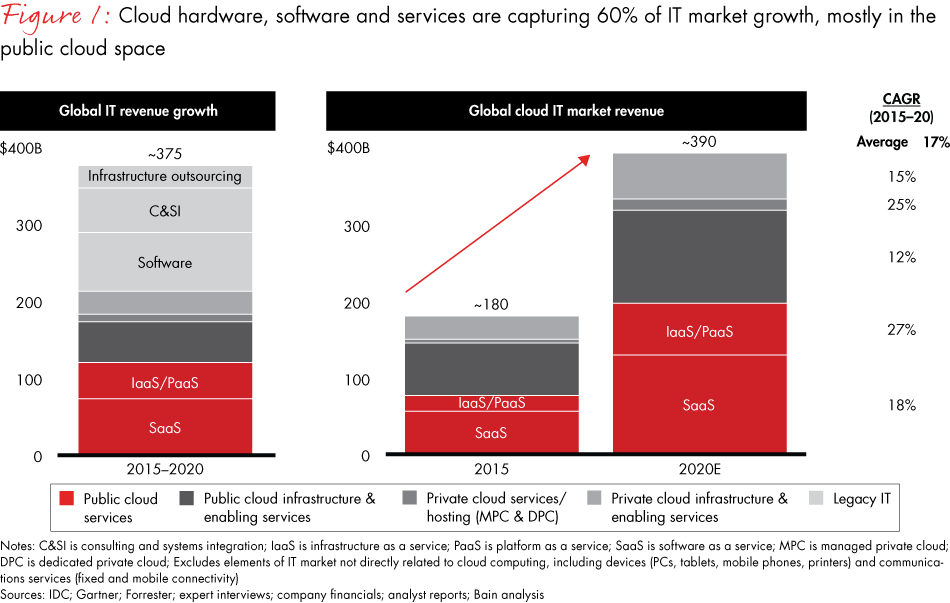
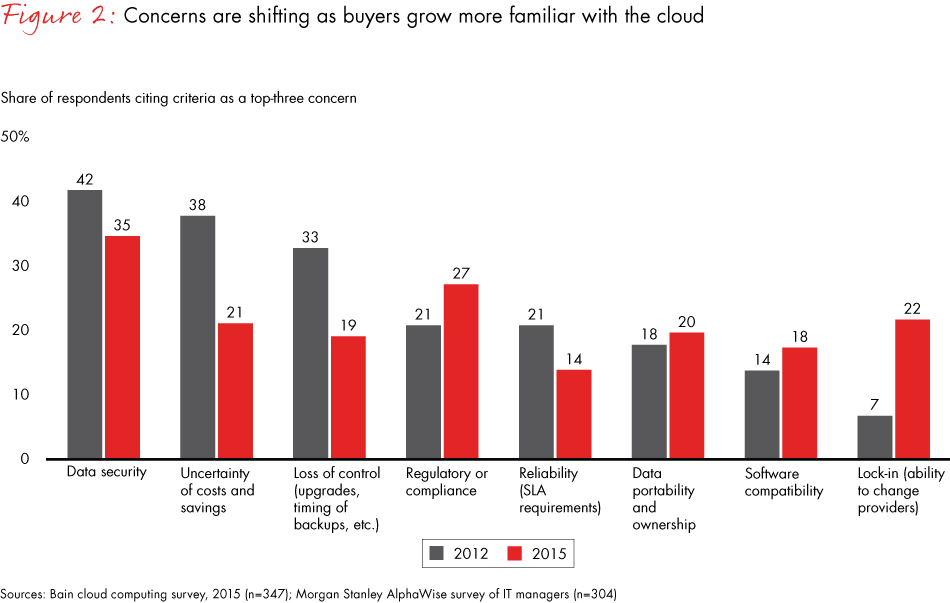
As we move into the next phase of the cloud’s growth, the profile of cloud buyers is changing. The early adopters that fueled the first waves of cloud adoption are being joined and overtaken by larger and more mainstream customers that, until recently, had taken a wait-and-see approach.
This shift has significant implications for technology providers, and executives need to understand the transformation that the cloud market is going through—and make the necessary changes to their offers, sales and marketing, support and organizations to successfully serve the customers coming off the sidelines. Only those technology providers that adapt to reach this mass market will emerge as likely winners in the next wave.
Five faces of the cloud
In 2011, to help providers navigate their way through this market transition, Bain surveyed almost 500 North American CIOs and other IT decision makers, and spoke with more than 25 cloud providers. Through this research, we identified five clusters of companies with common approaches to cloud computing. In three subsequent studies, the most recent in 2016, the clusters continue to prove an accurate and useful way of understanding how customers are adopting the cloud (see Figure 3).
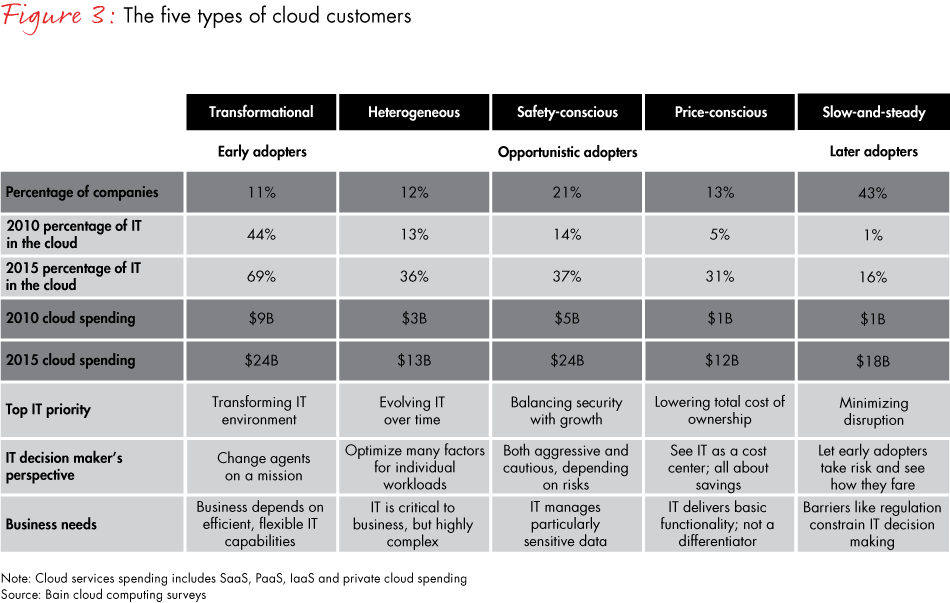
Transformational
These early adopters already use cloud computing heavily. Transformational customers are motivated to buy the cloud for performance and scalability, and focus less on cost savings. They look for innovative offerings with good support.
In 2010, these early adopters relied on one or more cloud models in about 40% of their IT environments, on average; in 2015, that percentage approached 70% (see Figure 4).
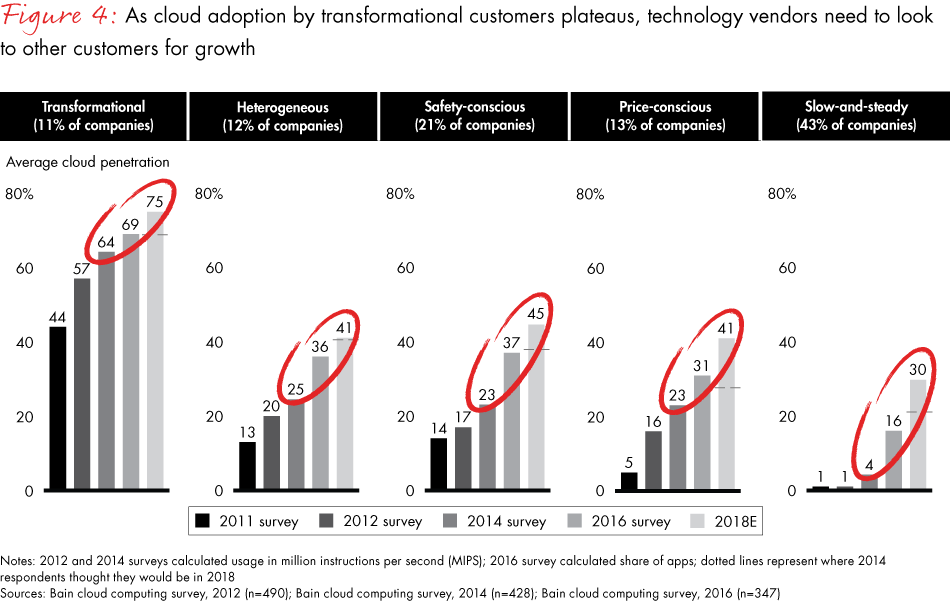
Most startling is the changing role of these customers in the cloud market. In 2011, transformational customers made up 11% of companies, but generated 47% of the demand for cloud services. Today, while these transformational customers drive innovation and set the bar for many customers, they represent 26% of cloud demand. Transformational customers are no longer the fastest-growing segment, with cloud adoption slowing down as their adoption reaches its peak.
When you think of transformational customers, digital businesses such as Netflix first come to mind. However, transformational customers come from many places. Take General Electric. In 2013, GE began its journey to the cloud with its oil and gas division initiating the migration of more than half of its applications to AWS. GE’s transition to the cloud continues with plans to move 9,000 applications to public infrastructure as a service (IaaS) over the next three years, reducing the number of its data centers from more than 30 to just 4.
Heterogeneous
Heterogeneous customers are also leaning in on cloud use, but have set a more measured pace of adoption due to the diversity of their existing IT environments and future IT needs.
These are customers like Land O’Lakes, which have segmented their existing workloads, moved some to software as a service (SaaS), moved others to a variety of IaaS and platform as a service (PaaS) providers, and maintained others on premise. Land O’Lakes is a significant user of Oracle, Microsoft and Google cloud solutions, choosing each for their workload-specific advantages.
Mark Brinda, a partner with Bain's Technology practice, discusses four things that technology providers can do to stay competitive in the cloud.
Safety-conscious
Safety-conscious customers are eager to adopt the cloud, but for a range of reasons—such as industry-specific regulation, national data sovereignty rules or the size of their companies—they prefer a private, dedicated cloud environment for most of their cloud applications. They select providers based on their ability to provide a secure, dedicated cloud environment at an affordable price. This segment has consistently represented about 20% of customers and has seen its share of cloud spending grow from 22% in 2011 to 26% in 2015.
The rate of adoption for these customers is frequently underestimated, and their pace of adoption over the past five years has consistently exceeded expectations. These customers prefer private cloud, but they are becoming active users of public cloud services as public cloud providers demonstrate an ability to meet their security requirements. While this customer segment tends to buy from large, established technology providers, they often consider emerging providers.
Progressive Insurance is an example of a security-conscious company. In 2012, Progressive began to consider the cloud, earlier than companies in the slow-and-steady segment. Progressive now uses a private version of Microsoft Office 365 ProPlus and other cloud applications that keep the company’s sensitive data private. Progressive also deployed a hybrid version of Azure specifically for innovative new offerings that make selective use of public cloud resources.

Changing Faces of the Cloud
As the cloud moves from niche to mainstream, providers can take three steps to adapt.
Price-conscious
Back in 2011, as prices for some cloud services were beginning to fall rapidly, we observed that price-conscious customers—those basing their decision to move to the cloud primarily on the ability of a cloud solution to save them money—were a small part of the market, roughly 12% of companies. We believed that a price war would not meaningfully change the attitudes of most customers toward the cloud, since the majority were looking for cost-neutral cloud solutions that delivered greater business flexibility and responsiveness.
After a massive jump in adoption, from 5% of total applications in 2010 to 23% in 2013, which corresponded to a period of rapid price declines by AWS, Google and Microsoft Azure, price-conscious customers have somewhat moderated their pace of adoption, increasing another 8 percentage points to 31 percentage points between 2013 and 2015. The price-conscious segment still comprises only 14% of total spending and represents about 13% of total customers. Cloud providers have realized the true motivations of most customers and have started focusing more on adding services that make their platforms more valuable and easier to use.
Halliburton is an example of a price-conscious cloud user. The company has deployed the cloud most aggressively in new business ventures where the cost of deploying new premise-based capacity combined with the risk of investing too much in resources in an unpredictable demand environment make the cloud’s value proposition particularly compelling. Halliburton’s DecisionSpace Well Engineering software, a free product provided to engineering schools to build awareness and engagement with the brand, was an ideal fit for a public PaaS environment. The company has deployed cloud-based software tools in Microsoft and IBM clouds in order to optimize return on investment on new business investments.
Slow-and-steady
These customers, for a range of reasons, were not yet ready to adopt cloud computing in a meaningful way. They are interested in the benefits of cloud computing, but want to minimize disruption and are careful in evaluating whether the benefits are worth the risks of new technology. Slow-and-steady customers are the largest segment of customers.
In the past five years, as cloud offerings have matured and the number of customer successes have grown, slow-and-steady customers have gone from the smallest to the fastest-growing segment, with the potential to become the largest segment in overall cloud spending in the next few years (see Figure 5). In 2011, slow-and-steady customers had only 1% of their applications, on average, in the cloud. By 2015, they had 16% in the cloud, and it is expected to grow to 30% by 2018.
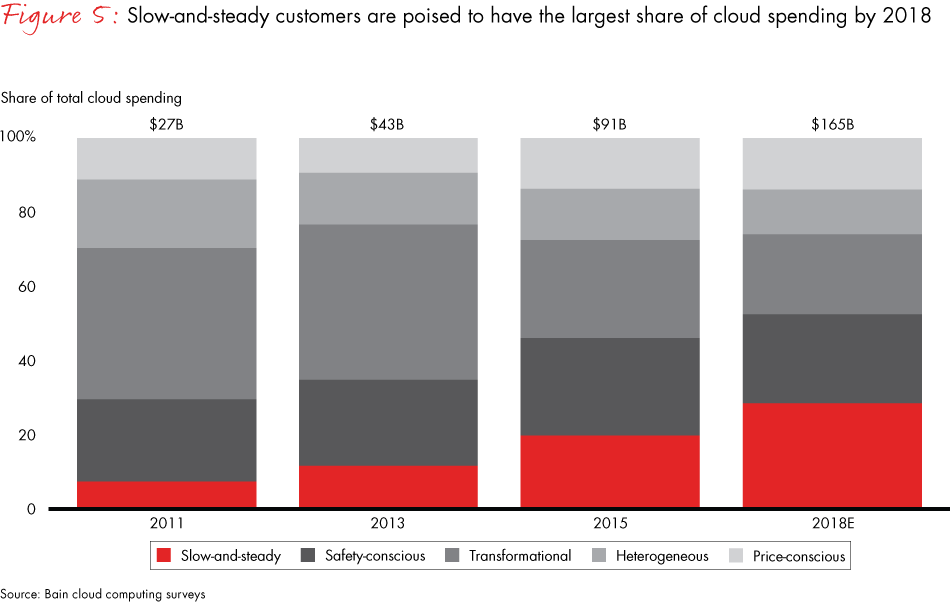
Many providers who had preexisting relationships with slow-and-steady customers assumed that these later moving customers would migrate to the cloud with them, if and when they ever did. These providers should take notice if they haven’t already. Slow-and-steady customers are as likely to use new providers as they are their incumbent providers. While they state a significantly higher preference for private cloud solutions, they are not waiting for compelling offers to hit the market to begin migrating. They are moving to public cloud in spite of these preferences.
Take Boeing, a company that was not considering the cloud in a significant way back in 2012. By 2014, the company had created a proprietary, on-premise PaaS solution based on open source code. Then it began to use AWS for some new applications. By 2016, it had begun moving select existing applications, like aviation analytics, to the public cloud.
Winning in the next phase of cloud evolution
The demand for cloud computing services has shifted from a small number of transformational customers to later adopters coming off the sidelines. This shift creates profound implications for technology providers as they pursue growth with these later adopters with different needs. Technology providers need to rethink their offers and operating models, from their go-to-market models and their organizations to their people, processes, incentives and systems.
Over the past five years, incumbent technology providers adapted their operating models to enable them to compete more effectively. Many created greater transparency and accountability by splitting out the cloud in their financial reporting, or as separate business units. Many hired new talent and overhauled their sales compensation systems to sell cloud services.
Many incubated new businesses, entered into strategic alliances and made billions of dollars in acquisitions. The results, however, have been mixed.
New entrants that emerged with the advent of cloud computing had fundamentally different operating models from the start, which were often better tuned to new market conditions created by the cloud. Their operating models were built for speed, with flat management structures, empowered teams and more efficient processes. However, their models will also be challenged, as new cloud buyers will have different needs.
More than ever, technology providers need to take a step back and reevaluate whether they are set up for success in this next wave of cloud computing.
- Invest to win big in a focused set of cloud battlegrounds. Saying you’re selling the cloud is like saying you’re in transportation. That could include everything from automobile manufacturing to managing taxi fleets or running airlines; all require different capabilities and focus. Traditional cloud market definitions, such as IaaS, PaaS, SaaS or private cloud, are blurring and reconfiguring. New battlegrounds are emerging in the cloud market, with distinct rules of the game and profit pools. Providers first need to define the cloud battlegrounds correctly. Then they need to pick the critical few where they can win and invest differentially. Today, many providers have either defined battlegrounds too broadly or are competing across too many to win big in any single one.
- Target the customer segments that best fit with your assets and capabilities. Slow-and-steady or safety-conscious customers have very different needs from the transformational customers that have been driving the market. Choosing which segments to go after, as well as which customers within those segments, will be essential for success.
- Reassess your offers, go-to-market model, organization and people, processes, incentives and systems for the next wave of cloud computing. Now is not the time to be complacent or assume that past changes will be sufficient to compete and win in this next wave of cloud computing. Incumbent technology providers should challenge themselves on whether the changes made to their operating models have been enough. Successful new entrants will increasingly be challenged, requiring them to adapt, even reinvent, their operating models.
The next chapter in cloud computing is being written now. The industry shakeout is under way, with several high-profile exits and business model redefinitions of technology providers. Over the coming years, the shake-out will intensify as new buyers increasingly drive demand for cloud services and new competitive battlegrounds replace old market definitions. Technology providers that recognize these trends early and adapt their offers and operating models most effectively will emerge as the winners.
Mark Brinda and Michael Heric are partners with Bain & Company in New York. Both work with Bain’s Global Technology practice.
The authors wish to acknowledge TSO Logic for providing data for this publication.




